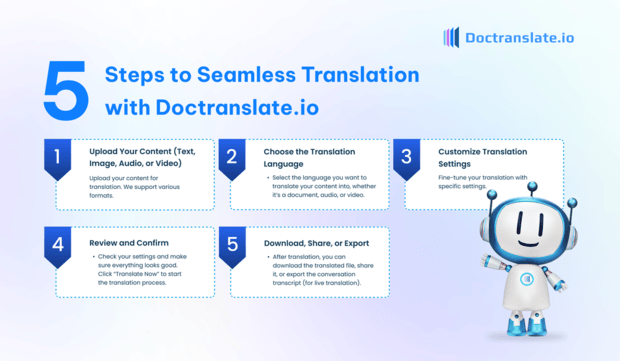Introduction
Translating documents is crucial for bridging language divides. It allows businesses and individuals to connect with a wider, global audience.
Breaking language barriers opens up new opportunities. Accurate translation ensures your message is understood clearly across different cultures.
DocTranslate.io offers a simple and effective solution for your translation needs. It handles various content types with ease and accuracy.
This guide specifically focuses on translating documents. We will walk you through the process of translating from Greek to English using **DocTranslate.io**.
Step-by-Step Guide: Translating Documents from Greek to English with DocTranslate.io
Step 1: Upload Your Content
The first step is getting your document into **DocTranslate.io**. You’ll need to access the website to begin.
Navigate to the document translation tool directly: Translate Document.
You can easily upload your file. Simply click the file picker area or drag and drop your document into the designated box.
**DocTranslate.io** supports common document formats. These include DOCX, PDF, PPTX, and XLSX files for your convenience.
If you are a new user, remember to register for an account. You receive 5 free credits upon signing up on the home page.
Step 2: Choose the Translation Language
Selecting the correct languages is vital for an accurate translation. **DocTranslate.io** makes this step straightforward.
First, specify the original language of your document. For this example, you will select ‘Greek’ as the source language.
Next, choose the language you want the document translated into. Here, you will select ‘English’ as the target language.
Double-checking your language selections ensures that the translation process yields the desired result.
Step 3: Customize Your Translation Settings
**DocTranslate.io** offers settings to refine your translation. Customizing these options enhances accuracy and suitability.
Consider the ‘Translation Type’. For technical or important documents, selecting ‘Professional’ translation is recommended for high accuracy. Learn more in the User Manual.
Specifying the ‘Domain’ helps the system understand the context. This is especially useful for technical documentation to improve terminology accuracy.
You can also select the desired ‘Tone’ for your translated document. This ensures the output matches the intended style, whether formal or informal.
Optionally, use features like My Dictionary. This allows you to pre-define terms for consistent translation across your document.
Step 4: Review and Confirm
Before initiating the translation, take a moment to review everything. This is a quick but important step.
Check that the document is uploaded correctly. Confirm that you have selected the correct source (Greek) and target (English) languages.
Verify the customization settings you chose. Ensure the domain, tone, and translation type meet your requirements.
Once you are satisfied with all the settings, simply click the “Translate Now” button to start the translation process.
Step 5: Download, Share, or Export
After the translation is complete, you can access your translated document. **DocTranslate.io** makes retrieval easy.
You can download the translated file directly to your computer. The platform works hard to maintain the original formatting of your document.
This means tables, images, and layout should remain largely intact. This saves you time on post-translation formatting.
Depending on the content type, you may also have options to share the translated output or export transcripts for live translations.

Conclusion
Translating Documents from Greek to English is streamlined with **DocTranslate.io**. The platform provides a user-friendly interface.
By following these simple steps, you can achieve accurate and efficient translations. You can tailor settings to meet your specific needs, like domain and tone.
Start translating your documents today to expand your reach. Connect with a global audience effectively by breaking language barriers.
Experience the power and ease of professional translation. Visit **DocTranslate.io** to get started on your translation projects!


Leave a Reply